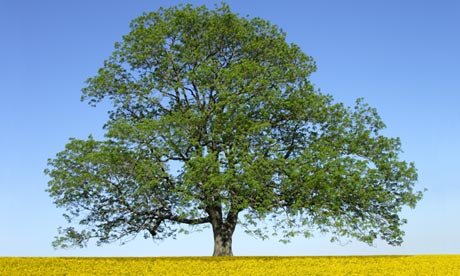Environment & Energy
Related: About this forumWoodland Trust predicts deadly fungus could kill a third of Britain's trees
http://www.guardian.co.uk/environment/shortcuts/2012/sep/26/fungus-kill-third-britains-trees?intcmp=122
The ash tree could become a sight of the past. Photograph: Rosemary Calvert/Getty Images
Imagine the British landscape with a third fewer trees. That is the chilling prediction being made this week by the Woodland Trust.
A fungus that has already killed 90% of ash trees in Denmark over the past seven years has now been detected in a handful of locations – none yet in the "wild" – after first being found at a nursery in Buckinghamshire in February. If our government does not act urgently, warns the Woodland Trust, all Britain's estimated 80m ash trees could be lost to the fungal disease known as "ash dieback", or Chalara fraxinea. There is no effective remedy apart from felling and burning affected trees and banning imports of live ash saplings from mainland Europe, where the fungus has taken hold. Some arborists fear such actions might already be too late.
As a child, growing up in Cornwall when Dutch elm disease was sweeping the UK, I remember staring up in awe at a row of majestic elms on the daily drive to school. Then, suddenly, they were gone. By the 90s, the disease had claimed more than 25m elms across the UK. But ash dieback could have an even more devastating impact. Alongside oak and birch, ash is one of the most common native broadleaf trees and accounts for roughly 30% of our "wooded landscape", which includes parks and hedgerows, as well as woods and forests. It is relatively fast growing, prized as excellent firewood and charcoal, and its strength and elasticity means it has a wide variety of uses – gates, tool handles, rowing oars, furniture, to name but a few.
GliderGuider
(21,088 posts)It makes me wonder if they're all somehow inter-related...
AverageJoe90
(10,745 posts)On the other hand, there are some things that ARE connected. If some other species of trees have been dying from fungal infections in the U.K. as well, then we can speculate about the possibility of weather changes being a factor.
GliderGuider
(21,088 posts)It gets transported from place to place by oil-fueled vehicles. And our use of oil is made necessary by our high-mobility civilization, which was made necessary by our growing population, which is growing because the development of money enabled more efficient production of material goods and food. So the spread of this fungus today is connected to the development of money 5,000 years ago.
If you look deeply enough, everything that happens in a civilization is connected to everything else. Sometimes it's through a long and subtle chain of intermediate connections, but in the end everything depends on and/or is dependent on pretty much everything else. Reality is all of a single piece, which is what makes it impossible to constrain, bound or isolate the side effects of solutions to apparently isolated problems.
The best we can hope for is to attenuate the impact of our solutions, but information theory says even that is ultimately ineffective. Every change in one part of a system causes new information to leak out into the rest of the system, through both space and time. That information changes the behaviour of every sub-system it enters, in one way or another. Sometimes these changes will be small, but small isn't the same as unimportant - as 400 ppm of CO2 is currently teaching us.
AverageJoe90
(10,745 posts)After all, it just took ONE disaffected Serbian nationalist shooting the Archduke to spark WWI. Just one atom bomb that led to the Cold War. Just one knocked-over lantern that started the burning the Windy City in that October day in 1871. Just one frontal boundary that caused the Super-Outbreak of 1974, etc. And each one of these events all led to many more.
GliderGuider
(21,088 posts)RobertEarl
(13,685 posts)That made me think of radiation. Radiation like that from all the nuclear testing, from Chernobyl, and from Fukushima.
It is well known that flora under stress becomes very susceptible to pathogens.
CRH
(1,553 posts)Last edited Thu Sep 27, 2012, 10:36 PM - Edit history (1)
and if wet summers is the direction of the new normal, best to move the ash more south. This is not said with callus disregard, only an observation, of our, humanity's, new normal of constant adjustment. It is sad because I was reared in a canopy of English Elm, believe it or not, in the San Juaquin valley. In the back yard was a Modesto Ash, a close relative to the subject in the OP.
edit: added last sentence